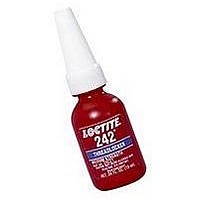PRODUCT DESCRIPTION
LOCTITE
LOCTITE
threaded fasteners which require normal disassembly with
standard hand tools. The product cures when confined in the
absence of air between close fitting metal surfaces and
prevents loosening and leakage from shock and vibration.
Suitable for applications on less active substrates such
as plated surfaces, where disassembly with hand tools is
required for servicing. The thixotropic nature of LOCTITE
®
substrate.
Mil-S-46163A
LOCTITE
Specification Mil-S-46163A.
ASTM D5363
Each lot of adhesive produced in North America is tested to
the general requirements defined in paragraphs 5.1.1 and
5.1.2 and to the Detail Requirements defined in section 5.2.
NSF International
Registered to NSF Category P1 for use as a sealant where
there is no possibilty of food contact in and around food
processing areas. Note: This is a regional approval. Please
contact your local Technical Service Center for more
information and clarification.
NSF International
Certified to ANSI/NSF Standard 61 for use in commercial and
residential potable water systems not exceeding 82° C. Note:
This is a regional approval. Please contact your local Technical
Service Center for more information and clarification.
TYPICAL PROPERTIES OF UNCURED MATERIAL
Technology
Chemical Type
Appearance (uncured)
Fluorescence
Components
Viscosity
Cure
Secondary Cure
Application
Strength
Specific Gravity @ 25 °C
Flash Point - See MSDS
Viscosity, Brookfield - RVF, 25 °C, mPa·s (cP):
Viscosity, Brookfield - RVT, 25 °C, mPa·s (cP):
reduces the migration of liquid product after application to the
Spindle 3, speed 2 rpm, Helipath
Spindle 3, speed 20 rpm, Helipath
Spindle 3, speed 20 rpm
®
®
®
242
242
242
®
®
®
provides the following product characteristics:
is tested to the lot requirements of Military
is designed for the locking and sealing of
Acrylic
Dimethacrylate ester
Blue liquid
Positive under UV light
One component - requires no mixing
Medium, thixotropic
Anaerobic
Activator
Threadlocking
Medium
LMS
1.0
≥5,000
800 to 1,600
*900 to 1,400
LMS
LMS
®
LMS
242
LMS
TYPICAL CURING PERFORMANCE
Cure Speed vs. Substrate
The rate of cure will depend on the substrate used. The graph
below shows the breakaway strength developed with time on
M10 steel nuts and bolts compared to different materials and
tested according to ISO 10964.
Cure Speed vs. Temperature
The rate of cure will depend on the temperature. The graph
below shows the breakaway strength developed with time at
different temperatures on M10 steel nuts and bolts and tested
according to ISO 10964.
Lubricity, ASTM D5648, K value, ASTM D 5648, %:
(In critical applications, it is necessary to determine the K
values independently. Henkel corporation makes no warranty of
specific performance on any individual fastener):
3/8 x 16 Phosphate & Oil Nuts, Bolts, Steel Washer
100
100
75
50
25
75
50
25
0
1min
0
1min
5min 10min
5min 10min
LOCTITE
30min 1h
30min 1h
Technical Data Sheet
3h
3h
®
December-2009
Stainless steel
6h
6h
242
-10 to 10
LMS
24h
24h
®




